Every click matters in League of Legends; so your settings better keep up. Pros don’t just rely on mechanics; they fine-tune every control, HUD element, and graphic detail for max clarity and zero delay.
This guide breaks down the best competitive LoL settings, pulling from pro setups across graphics, hotkeys, and interface tweaks. If you want your inputs to feel crisp and your plays to land cleaner, this is where you start.
Optimized League of Legends Graphics Settings for Competitive Play
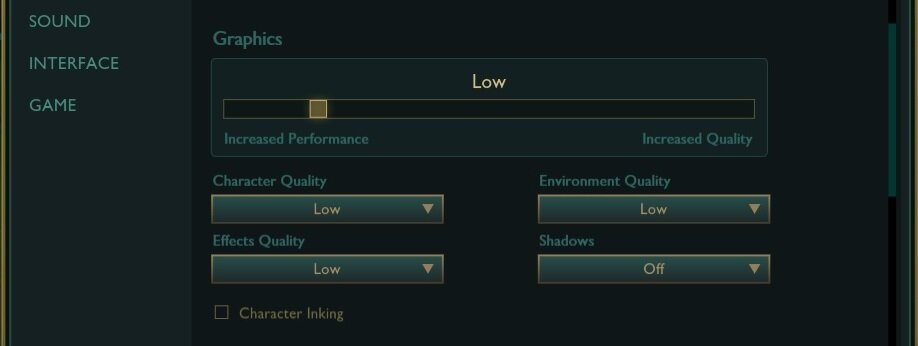
You’re not here to admire Summoner’s Rift, you’re here to climb. Every blur, glow, or ambient effect is one more thing muddying your read on a teamfight.
Pros kill the eye candy for a reason: clarity wins games.
Core Graphics Settings
These fundamental settings have the greatest impact on both performance and visual clarity:
| Setting | Recommended Value | Impact | Notes |
|---|---|---|---|
| Resolution | Native Monitor Resolution | MEDIUM | Use your monitor’s native resolution (commonly 1080p) for best clarity. Going lower reduces quality with minimal performance gain in LoL. |
| Window Mode | Full Screen | HIGH | Full Screen provides lowest input lag and best performance. Borderless is slightly more convenient but may add input delay if you’re not using Windows 11 with “Optimizations for windowed games” enabled. |
| Character Quality | Medium | MEDIUM | Medium maintains clarity of champions without unnecessary GPU load. High/Very High adds mostly cosmetic details. |
| Environment Quality | Low or Medium | MEDIUM | Low-Medium reduces map details but maintains essential visibility. Environmental details are largely cosmetic. |
| Effects Quality | Low | HIGH | Low reduces visual noise from particles during teamfights while keeping ability visibility intact. Significant performance boost. |
| Shadow Quality | Off | HIGH | Disabling shadows provides a substantial FPS boost. Shadows offer minimal competitive advantage and are purely cosmetic. |
| Anti-Aliasing | Off | MEDIUM | Disabling AA improves performance and reduces slight blurring. League’s cartoon style makes jagged edges less noticeable. |
| Vertical Sync | Off | HIGH | V-Sync adds significant input lag. Disable for most responsive gameplay, even if it means occasional screen tearing. If you really hate screen tearing – combine G-Sync + V-Sync + Low Latency Mode in the Nvidia Control Panel. |
Pro Tip: Frame Rate Management
For optimal performance in League of Legends, set your frame rate cap to match your monitor’s refresh rate (typically 144Hz or 240Hz). If you experience frame drops during teamfights, consider setting a cap 10-20% below your monitor’s refresh rate to maintain consistent performance. For example, on a 144Hz monitor, a 120 FPS cap can provide more stable frame times than uncapped frames that fluctuate between 160-200 FPS.
To set a frame rate cap, use the in-game settings or create a custom FPS cap in your GPU control panel. Consistent frame timing often feels smoother than higher but variable FPS.
Advanced Visual Optimizations
These additional settings can further enhance clarity and performance:
| Setting | Recommended Value | Location | Notes |
|---|---|---|---|
| Character Inking | Off | Video → Advanced | Disabling character outlines provides a minor performance boost with no gameplay impact. |
| Screen Shake | Off | Game → Interface | Disable screen shake to maintain a steady view during important moments like critical strikes. |
| Hide Eye Candy | On | Video → Advanced | Removes ambient creatures and animations that can be distracting during gameplay. |
| Colorblind Mode | On (Optional) | Interface → Accessibility | Many pros enable colorblind mode even with normal vision. It creates higher contrast health bars that are easier to track in teamfights. |
| Wait for Vertical Sync | Never | Video → Advanced | Another form of V-Sync that should be disabled to minimize input lag. |
| Low Spec Mode | On (if needed) | Client Settings | Reduces resource usage in the game client (not in-match). Helpful if your PC struggles or you want to preserve resources. |
| Enable HUD Animations | Off | Interface | Disabling HUD animations makes health/mana changes appear instantly rather than animating. |
// Navigate to: C:\Riot Games\League of Legends\Config\
// Edit game.cfg to add these performance settings:
[Performance]
ShadowsEnabled=0
CharacterInking=0
EnableHUDAnimations=0
EnableGrassSwaying=0
PerPixelPointLighting=0
EnableFXAA=0
EnvironmentQuality=1
EffectsQuality=1
CharacterQuality=2
AutoPerformanceSettings=0
Impact of Graphics Settings on Performance
Understanding which settings impact performance the most helps you make informed trade-offs:
| Setting | FPS Impact | Visual Impact | Pro Usage |
|---|---|---|---|
| Shadow Quality | 15-25% increase when disabled | Minor loss of depth perception | 90% of pros disable shadows |
| Effects Quality | 10-20% increase on Low | Less visual noise in teamfights | 85% use Low effects |
| Environment Quality | 5-15% increase on Low | Simpler map textures | Mixed (Low-Medium) |
| Anti-Aliasing | 3-8% increase when disabled | Slightly more jagged edges | 65% disable AA |
| Character Quality | 2-5% increase on Medium vs High | Slightly less detailed champions | Most use Medium |
| Character Inking | 1-3% increase when disabled | No outlines around champions | 70% disable inking |
| Window Mode | 5-10% better in Fullscreen | None | Fullscreen preferred |
| Hide Eye Candy | 1-2% increase when enabled | No ambient creatures/animations | 80% hide eye candy |
Even with a powerful system, teamfights can cause FPS drops due to the high number of particle effects. If you experience stuttering during 5v5 engagements, focus on reducing Effects Quality and Shadow Quality first, as these have the largest impact during intensive moments.
Monitor your performance using the built-in FPS counter (Ctrl+F) during teamfights rather than while farming in lane to get an accurate picture of your performance under stress.
Movement and Camera Controls for League of Legends
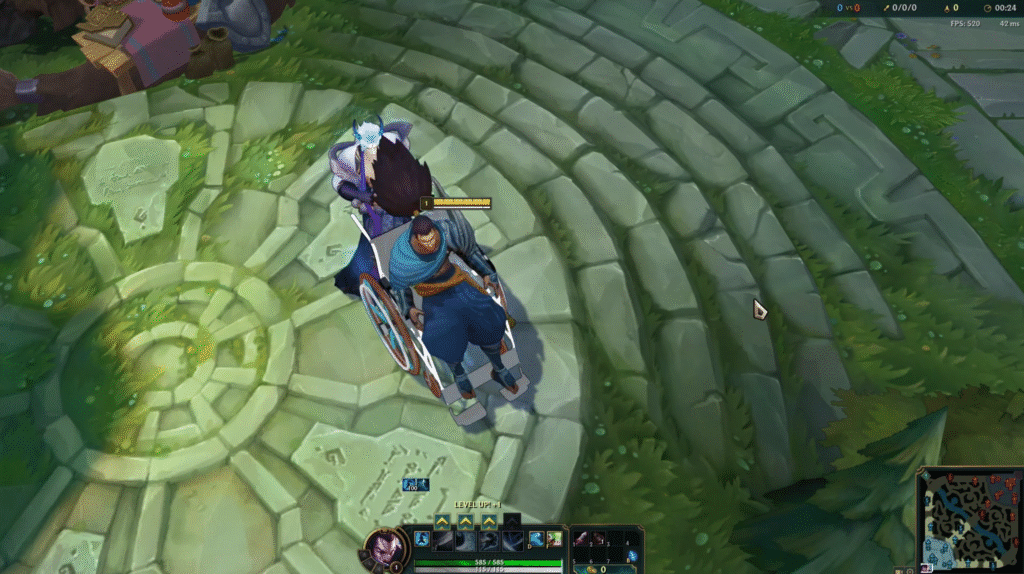
How you move is how you win. Pro-level control in League is efficient. That’s why top players rebind, strip down, and fine-tune everything. If your camera’s dragging or your keys feel clunky, it’s costing you plays.
Champion Movement Settings
These settings determine how you control your champion’s movement around the map:
| Setting | Recommended Value | Why It Matters |
|---|---|---|
| Primary Movement | Right-Click (mouse) | Standard mouse movement provides the most precise positioning. The traditional right-click movement allows for quick, accurate positioning in lane and teamfights. |
| Mouse Sensitivity | 50 (with 1600 DPI) | The default 50 sensitivity is what most pros use with a ~1600 DPI mouse. This offers balanced precision and speed for cursor movement. |
| Attack Move Click | Enabled, bound to A or Shift+Right-Click | Attack-move helps with kiting and prevents misclicks during intensive trading. Having it readily accessible improves attack precision. |
| Attack Move on Cursor | Enabled | When enabled, attack-move targets the enemy closest to your cursor, not to your champion. This gives better control in teamfights where multiple targets are nearby. |
| Target Champions Only | Bound to accessible key (~ or thumb mouse button) | Essential for tower dives or fighting near minions. Prevents accidental clicks on minions or structures during crucial engagements. |
| Treat as Toggle | Enabled | Makes “Target Champions Only” a toggle (press once to activate, press again to deactivate) rather than having to hold the key down during fights. |
| Stop Command | S key (default) | The stop command immediately halts your champion. Crucial for animation canceling, last-hitting, and juking skillshots. |
Pro Tip: Attack Move Configuration
For the most efficient kiting, most pros use one of these two attack-move setups:
- A + Left-Click: Press A, then left-click to attack-move to that location.
- Shift + Right-Click: Hold Shift while right-clicking to perform attack-move commands.
The second method allows for faster transitions between movement and attacking, which is especially helpful for ADC players who need to kite efficiently. Whichever method you choose, make sure “Attack Move on Cursor” is enabled in the settings to ensure you hit the target closest to your cursor rather than the closest to your champion.
Camera Control Optimization
How you control your camera view is one of the most important skill differentiators in League:
| Setting | Recommended Value | Why It Matters |
|---|---|---|
| Camera Mode | Unlocked | Unlocked camera is essential for proper map awareness and skillshot execution. Using a locked camera severely limits your field of view and awareness. |
| Camera Move Speed | 50-70 (Medium-Fast) | A moderately fast camera allows you to quickly pan across the map while maintaining precision. Too slow limits responsiveness, too fast becomes difficult to control. |
| Camera Grip (Spacebar) | Hold Spacebar to center | Use Spacebar to temporarily center the camera on your champion during hectic fights, then release for wider view. This provides the best of both worlds. |
| Per-Side Offset | Enabled | Slightly offsets camera based on which side of the map you’re on for better visibility. Especially useful for blue vs. red side. |
| Camera Scroll (Edge Pan) | Enabled | Allows moving the camera by pushing cursor to screen edges. Some pros use a combination of edge panning and keyboard (WASD or arrow keys) for precise adjustments. |
| Semi-Locked Camera | Disabled | The semi-locked mode limits camera distance from your champion. This restricts vision and is generally not used by high-level players. |
| Camera Key Binds (F2-F5) | Enabled (or rebound to preference) | F1-F5 keys are used to quickly check on teammates. Many pros constantly check other lanes using these keys. If F-keys are uncomfortable, rebind them to more accessible keys. |
Playing with a permanently locked camera is one of the biggest mistakes new players make. While it may feel comfortable initially, it severely limits your ability to:
- Track enemies outside your immediate vicinity
- Prepare for incoming ganks
- Execute long-range skillshots
- Monitor important objectives
- Coordinate with your team
If you currently use locked camera, gradually transition to unlocked by practicing in normals. Start by unlocking for brief periods and increase duration as you become comfortable. Use spacebar to center when needed, but aim to play primarily unlocked.
Mouse Settings and Optimizations
Your mouse settings both in-game and at the system level impact your mechanical precision:
| Setting | Recommended Value | Location |
|---|---|---|
| In-Game Mouse Speed | 50 (Default) | LoL Game Settings → Game → Mouse Speed |
| Mouse DPI | 800-1600 | Mouse Software or Hardware Setting |
| Windows Mouse Speed | 6/11 (Default) | Windows Settings → Mouse Properties |
| Enhance Pointer Precision | Disabled | Windows Settings → Mouse Properties → Pointer Options |
| Cursor Scale | 50-75% | LoL Interface Settings → Cursor Scale |
| Legacy Cursor | Optional (Preference) | LoL Interface Settings → Legacy Cursor |
| Show Attack Range | Enabled | LoL Game Settings → Interface → Show Attack Range |
Type "Mouse Settings" into the Windows Search Bar.
Locate "Enhance Pointer Precision" and make sure it's turned off.
This prevents mouse acceleration being used in games that do not support raw input.
HUD and Interface Optimization
Your interface settings determine how game information is presented and how much screen space is available for actual gameplay.
HUD Size and Positioning
Optimize your Heads-Up Display (HUD) elements for maximum visibility and minimal screen obstruction:
| Setting | Recommended Value | Impact |
|---|---|---|
| HUD Scale | 35-50% | HIGH |
| Minimap Scale | 100% (Maximum) | HIGH |
| Chat Scale | 50% | MEDIUM |
| Minimap Position | Right (default) or Left (preference) | LOW |
| Ability Cooldown Display | Seconds or MM:SS | MEDIUM |
| Show Spell Costs | Enabled | MEDIUM |
| Show Summoner Names | Disabled (show champion names) | MEDIUM |
| Health Bar Size | Medium-Large | MEDIUM |
Pro Tip: Minimap Optimization
The minimap is your most important tool for map awareness. Configure these additional minimap settings for optimal information:
- Show Champion Names: Enabled – Helps identify which champions are where
- Show Neutral Camp Timers: Enabled – Shows jungle camp respawn timers
- Minimap Movement: Disabled – Prevents accidental clicks on the minimap when escaping downward
- Minimap Icons: Optimal Size (not too small to recognize, not too large to clutter)
Practice regularly glancing at your minimap between CS or ability casts. Top players check their minimap as often as every 3-5 seconds to maintain awareness.
While reducing HUD elements frees up screen space, don’t make them so small that you struggle to read critical information. Find the balance where:
- You can easily see your health, mana, and cooldowns without straining
- The minimap is large enough to spot enemy movements
- UI elements don’t obstruct your view of the battlefield
Most pros use a HUD scale of around 35-50% and maximize the minimap size to 100%. Start at 50% and adjust downward gradually as you get comfortable.
Visual Clarity Settings
These settings enhance your ability to distinguish important game elements:
| Setting | Recommended Value | Why It Matters |
|---|---|---|
| Colorblind Mode | Enabled (even for non-colorblind) | Creates higher contrast health bars and team colors that are easier to track in chaotic teamfights. |
| Show Attack Range | Enabled | Displays your auto-attack range when using attack move, helping with positioning and kiting. |
| Use Relative Team Colors | Enabled | Makes your team always blue and enemy team always red regardless of which side you’re on, creating consistent visual cues. |
| Show Health Bar Damage | Enabled (Split) | Shows incoming damage as separate health bar segments before they occur, helping with damage estimation. |
| Show Loss of Control UI | Enabled | Displays a clear indicator with duration when you’re stunned, silenced, or otherwise CC’d. |
| Chat Timestamps | Enabled | Adds timestamps to chat messages, helping track timers and events mentioned by teammates. |
| Flash on Low Health | Enabled | Creates a visual alert when your health drops critically low, drawing attention to your health status. |
| Global Alert Volume | Enabled (High) | Ensures you hear important global ability notifications like Karthus ultimate, Shen teleport, etc. |
// Navigate to: C:\Riot Games\League of Legends\Config\ // Edit game.cfg to add these interface settings: [FloatingText] Damage=1 Experience=0 Gold=0 ManaDamage=0 [HUD] ShowNeutralCamps=1 GlobalScale=0.4500 MinimapScale=1.0000 ChatScale=0.5000 ShowTimestamps=1 EnableLineMissing=1 ShowAllChannelChatSpectator=0 ShowAttackRadius=1 NumericCooldownFormat=1 ShowSpellCosts=1 ShowChampionIndicator=1 [LossOfControl] ShowSlows=0
Hotkeys and Keybinding Optimization
Efficient hotkeys can significantly improve your reaction time and mechanical execution. Professional players optimize their keybinds for maximum efficiency and accessibility. While some settings are personal preference, certain configurations provide objective advantages.
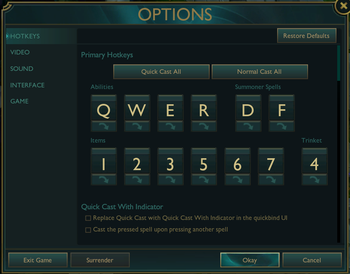
Ability Casting Settings
How your abilities are cast has a major impact on your reaction time and precision:
| Setting | Recommended Value | Impact | Notes |
|---|---|---|---|
| Cast Mode | Quick Cast (Smart Cast) | HIGH | Abilities fire immediately on key press without requiring a second click. Saves crucial milliseconds in fights. |
| Quick Cast with Indicator | Shift + Q/W/E/R | MEDIUM | Bind Shift+Ability to show range indicators when learning new champions or for precision skillshots. |
| Self-Cast | Alt + Ability (default) | HIGH | Automatically casts abilities on yourself without clicking your champion – crucial for shields and buffs. |
| Normal Cast | Ctrl + Q/W/E/R (optional) | LOW | Alternative binding for occasional precise targeting. Most pros rarely use this once comfortable with Quick Cast. |
| Level Up Ability | Ctrl + Q/W/E/R | MEDIUM | Quickly level abilities with keyboard rather than clicking. Essential during fights where every second counts. |
| Summoner Spells | D and F (default) | MEDIUM | Standard keys for summoners. Which spell goes on which key is personal preference (Flash on D or F). |
Pro Tip: Quick Cast Transition
If you’re not used to Quick Cast (Smart Cast), the transition can be challenging but worthwhile. Try this step-by-step approach:
- Start with Quick Cast with Indicator on all abilities to see ranges while still getting faster cast times
- Once comfortable, switch simple targeted abilities (like point-and-click spells) to full Quick Cast
- Gradually transition skillshots to full Quick Cast as you memorize their ranges
- Keep Shift+Ability bound to Quick Cast with Indicator for situations requiring precise aiming
Nearly all professional players use Quick Cast for faster execution. The milliseconds saved can mean the difference between landing a crucial stun or missing it entirely.
Item and Utility Hotkeys
Optimize access to items and critical commands with these key configurations:
| Function | Default Binding | Recommended Binding | Notes |
|---|---|---|---|
| Item Slots 1-3 | 1, 2, 3 | 1, 2, 3 (unchanged) | These keys are easily accessible and work well for most players. Use for core active items. |
| Item Slots 4-6 | 4, 5, 6 | 4, T, G (or mouse buttons) | Keys 5-6 are harder to reach quickly. Rebind to closer keys or mouse buttons for better access. |
| Trinket Ward | 4 | 4 or Mouse Button | Quick access to wards is essential. The default 4 works well, or a mouse side button. |
| Target Champions Only | ` (backtick) | Mouse Button or ~ (tilde) | This critical function deserves an easily accessible key. Many pros bind to a thumb mouse button. |
| Attack Move Click | A (then left-click) | A or Shift + Right-Click | Either the default A or using Shift+Right-Click works well. Configure in settings for one-click execution. |
| Center Camera | Space | Space (unchanged) | The spacebar is perfect for quick camera centering during fights while still allowing unlocked camera. |
| Emotes and Mastery | Various | Non-critical keys | Bind to keys that won’t interfere with gameplay if accidentally pressed. |
// Navigate to: C:\Riot Games\League of Legends\Config\
// Edit input.ini to add these custom keybindings:
[GameEvents]
evtUseItem4=[4] # Trinket ward on 4
evtUseItem5=[t] # Item slot 5 on T
evtUseItem6=[g] # Item slot 6 on G
evtPlayerAttackMoveClick=[a],[Shift][Button 2] # Attack move on A and Shift+Right-Click
evtCameraSnap=[Space] # Center camera on Spacebar
evtPlayerMoveClick=[Button 2] # Move on right-click
evtShowCharacterMenu=[c] # Stats on C
evtToggleTargetingOnlyChampions=[`] # Target champs only on backtick
evtSmartPingMG=[g] # Smart ping wheel on G
evtChatHistory=[z] # Chat history on Z
evtShowScoreBoard=[Tab] # Scoreboard on Tab
evtSelfCastItem1=[Alt][1] # Self-cast item 1
evtSelfCastSpell1=[Alt][q] # Self-cast Q ability
evtSelfCastSpell2=[Alt][w] # Self-cast W ability
evtSelfCastSpell3=[Alt][e] # Self-cast E ability
evtSelfCastSpell4=[Alt][r] # Self-cast R ability
evtCastSpell1Smart=[q] # Quick cast Q
evtCastSpell2Smart=[w] # Quick cast W
evtCastSpell3Smart=[e] # Quick cast E
evtCastSpell4Smart=[r] # Quick cast R
evtCastAvatarSpell1Smart=[d] # Quick cast Summoner 1
evtCastAvatarSpell2Smart=[f] # Quick cast Summoner 2
evtCastSpell1indicator=[Shift][q] # Q with indicator
evtCastSpell2indicator=[Shift][w] # W with indicator
evtCastSpell3indicator=[Shift][e] # E with indicator
evtCastSpell4indicator=[Shift][r] # R with indicator
Communication and Advanced Command Keys
Efficient communication and specialized commands improve team coordination:
| Function | Default Key | Recommended Key | Notes |
|---|---|---|---|
| Standard Ping | G | G or Mouse Wheel Click | Quick access to the ping wheel for communicating intentions and warnings to teammates. |
| Retreat Ping | V | V or Alt+Click | Danger/retreat pings need to be quickly accessible to warn teammates. |
| Emote Wheel | T | Non-critical key | If you use T for an item slot, move emotes to a less critical key like Y or H. |
| Champion Mastery | Ctrl+6 | Keep default or unbind | Not gameplay critical; some players unbind to avoid accidental taunts. |
| Camera to Allies (F2-F5) | F1-F5 | F1-F5 or rebind if inaccessible | Crucial for map awareness. If F-keys are hard to reach, consider rebinding to more accessible keys. |
| Chat Channel Toggle | Shift+Enter | Default is fine | Switches between team/all chat; not critical for gameplay but useful for communication. |
| Quick Message Macros | None by default | Custom binds (optional) | Some players create macros for common phrases like “Dragon in 1 min” to streamline communication. |
Pro Tip: F-Key Usage
The F1-F5 keys (for camera control to allies) are underutilized by many players but heavily used by pros, especially junglers and support players. They allow you to quickly check other lanes without clicking the minimap.
If you find the F-keys uncomfortable to reach, consider rebinding them to more accessible keys or mouse buttons. Practice regularly tapping these keys between CS or while moving to develop the habit of checking other lanes. This single habit can dramatically improve your map awareness and game impact.
LoL Audio Configuration for Competitive Advantage
While League of Legends isn’t as audio-dependent as some games, proper sound configuration can provide valuable gameplay information and help you maintain focus.

Plus, sometimes, you just wanna mute your teammates, and lock-in.
Sound Balance Configuration
Prioritize important audio cues by adjusting these volume levels:
| Audio Channel | Default Volume | Recommended Volume | Importance |
|---|---|---|---|
| Master Volume | 100% | 70% | Overall control – adjust to comfortable level |
| Music Volume | 70% | 0-20% | Low priority – mostly aesthetic, can be distracting |
| Sound Effects | 100% | 80-100% | High priority – contains important ability sounds |
| Announcer Voice | 100% | 50-80% | Medium priority – provides kill/objective information |
| Champion Voice | 70-100% | 20-50% | Low priority – mostly flavor text |
| Ambient Sound | 80% | 0-30% | Very low priority – purely atmospheric |
| Ping Volume | 100% | 80-100% | High priority – critical team communication |
Pro Tip: Critical Audio Cues
Pay particular attention to these important sound cues that can give you advance warning:
- Global Ultimate Sounds: Abilities like Shen’s ult, Karthus’s Requiem, or Twisted Fate’s Destiny have distinct audio tells
- Jungle Camp Sounds: You can hear camps being attacked even through fog of war
- Flash Sound: The summoner spell Flash has a distinctive sound that can alert you to enemy position changes
- Teleport Sound: Teleport has a unique sound when starting and completing
- Ward Placement: Wards make a specific sound when placed
Keep sound effects volume high to ensure you hear these critical gameplay sounds that can provide information about enemy positions and intentions.
// Navigate to: C:\Riot Games\League of Legends\Config\ // Edit game.cfg to add these audio settings: [Sound] MasterVolume=70.0000 MusicVolume=10.0000 AnnouncerVolume=60.0000 VoiceVolume=30.0000 SfxVolume=90.0000 AmbienceVolume=20.0000 PingVolume=90.0000 [VoiceChat] InputDevice=Default InputVolume=50.0000 ActivationSensitivity=50.0000 InputMode=0
Audio Hardware and Windows Settings
Optimize your system-level audio settings for the clearest game sounds:
- Headphones vs. Speakers:
- Headphones provide better positional audio and are preferred by almost all competitive players
- Stereo headphones are sufficient for League (unlike FPS games, surround is less critical)
- Use comfortable headphones that won’t cause discomfort during long sessions
- Windows Sound Settings:
- Set your gaming headphones/speakers as the default audio device
- Disable all audio enhancements in Windows sound properties
- Set sound quality to 16-bit, 48kHz for optimal performance
- Disable “Spatial Sound” features unless you specifically prefer them
- Background Applications:
- Close or mute audio from Discord, Spotify, web browsers, etc. during competitive matches
- If using voice comms, ensure they’re at a balanced level that doesn’t drown out game sounds
- Disable Windows notification sounds during gameplay
Many gaming headsets and sound cards come with software that offers various “enhancements” like virtual surround sound, bass boost, or equalizer presets. For competitive play, it’s generally best to disable these features as they can:
- Distort important game sounds
- Add audio processing latency
- Make certain frequency ranges overpowering
- Create inconsistent sound experiences between sessions
Use a flat, neutral audio profile for the most accurate representation of game sounds. If you do use equalizer settings, create a specific profile for League that slightly emphasizes mid-range frequencies where most game sounds and voice cues occur.
Professional Player Configurations
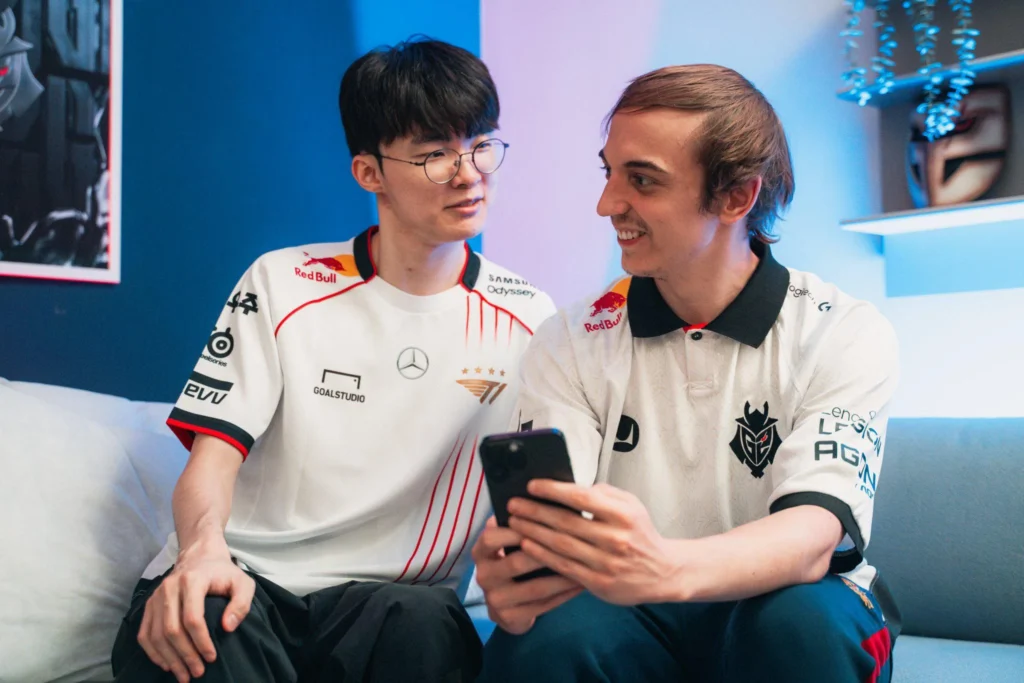
Examining the settings used by top League of Legends professionals can provide valuable insights into optimization. While personal preference plays a role, there are clear patterns in how the best players configure their game for maximum competitive advantage.
- Resolution1920×1080
- Window ModeBorderless
- Graphics QualityHigh (Char), Low (Shadows)
- Cast ModeQuick Cast All
- Flash KeyF
- Camera Speed50 (Default)
- Mouse DPI1800
- HUD Scale33%
- Resolution1920×1080
- Window ModeFullscreen
- Graphics QualityLow
- Cast ModeQuick Cast All
- Flash KeyF
- Camera Speed50
- Mouse DPI3200
- HUD Scale33%
- Resolution1920×1080
- Window ModeBorderless
- Graphics QualityLow (Effects Medium)
- Cast ModeQuick Cast All
- Flash KeyD
- Camera Speedn/a
- Mouse DPIn/a
- HUD Scalen/a
- Resolution1920×1080
- Window ModeBorderless
- Graphics QualityHigh (Char/Env), Shadows Off
- Cast ModeQuick Cast All
- Flash KeyD
- Camera Speed33
- Mouse DPI2500
- HUD Scale30%
- Resolution1920×1080
- Window ModeFullscreen
- Graphics QualityLow-Medium
- Cast ModeQuick Cast All
- Flash KeyF
- Camera Speedn/a
- Mouse DPI2100
- HUD Scalen/a
- Resolution1920×1080
- Window ModeBorderless
- Graphics QualityMedium
- Cast ModeQuick Cast All
- Flash KeyF
- Camera Speed50
- Mouse DPI1600
- HUD Scale20%
Keeping Optimal LoL Settings
Optimizing your League of Legends settings is not a one-time task but an ongoing process. As you grow as a player, your preferences may evolve, and game updates may require adjustments to your configuration. However, the fundamental principles of maximizing visibility, reducing input lag, and streamlining controls remain constant.
Start by implementing the most impactful changes first – Quick Cast, unlocked camera, reduced HUD scale, and maximized minimap – then gradually adjust other settings as you become comfortable. With time, your optimized configuration will become second nature, allowing you to focus entirely on outplaying your opponents on the Rift.
FAQs
How to make LoL graphics better?
Crank up the in-game settings like Texture and Character Quality for sharper visuals. Use higher resolutions, and enable anti-aliasing if your PC can handle it. Just keep an eye on your FPS; looks aren’t worth lag.
How much FPS is good for League of Legends?
120 FPS is the sweet spot for most players; smooth and reliable. If you have a higher refresh rate monitor, aim for 165 FPS or higher for extra fluidity.
What is the best FPS setting?
Set your FPS cap to match your monitor’s refresh rate (usually 120, 144, or 165 Hz). Unlimited typically causes stutters and you should avoid it.
How to set max FPS in League of Legends?
Go to Settings > Video, then adjust the “Frame Rate Cap” to your desired max (avoid going over 360 FPS or using uncapped to avoid getting stutters).
How do I max out my FPS?
Lower graphics settings like Shadows and Effects, set resolution to native, and close background apps. Updating your GPU drivers can also squeeze out extra frames.
How to make LoL run smoother?
Lower in-game graphics, enable “Low Spec Mode,” and close any unnecessary programs running in the background. Make sure your drivers are up-to-date and your PC isn’t overheating.

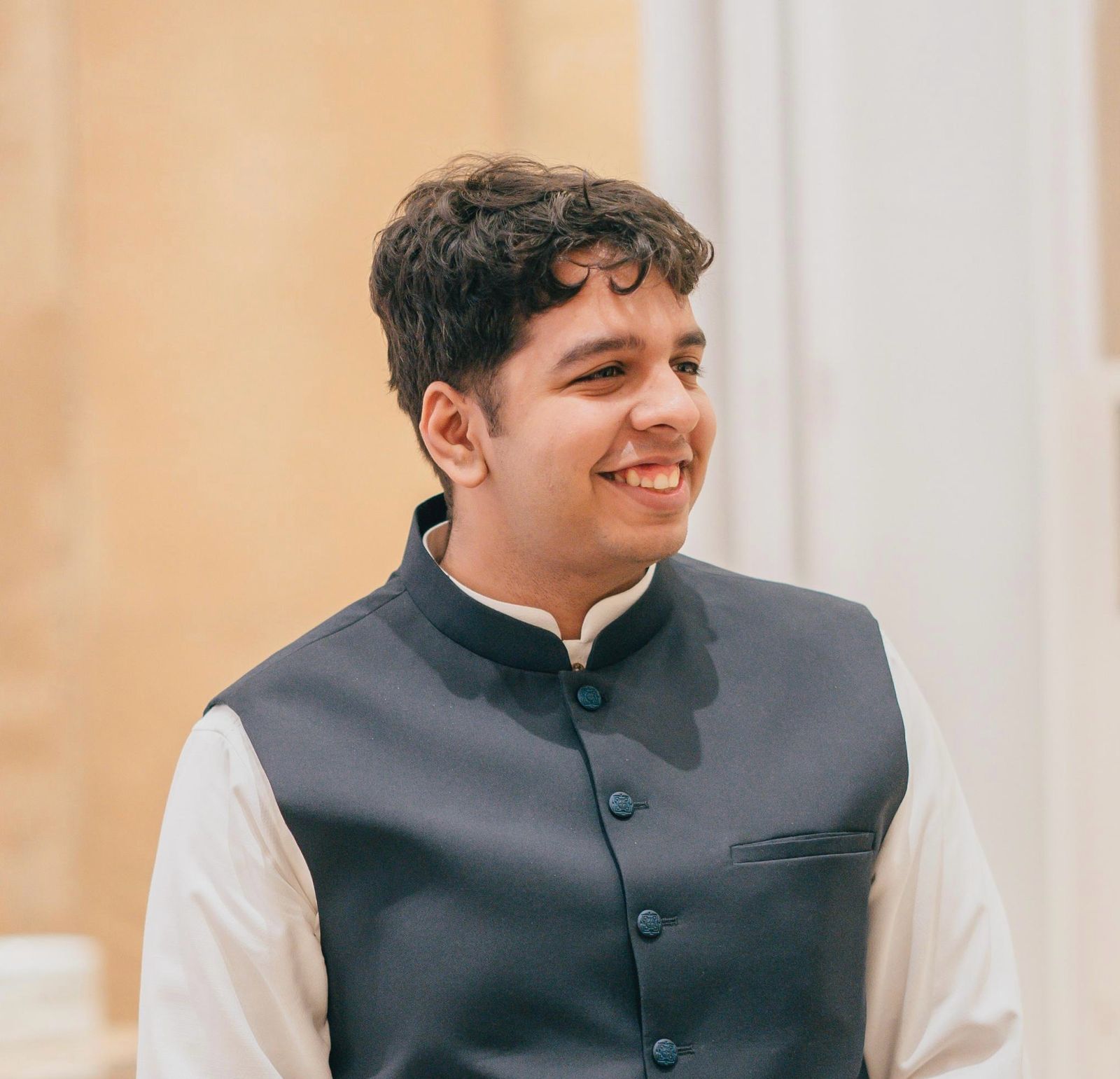
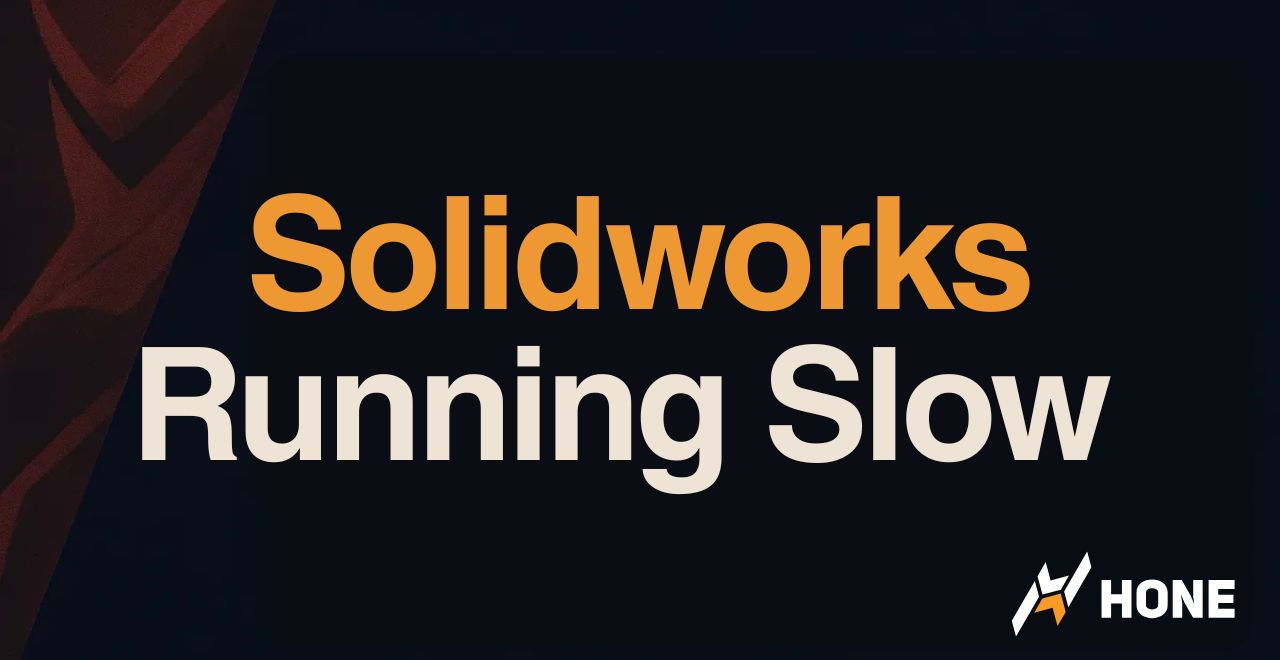



 Discord
Discord
 Instagram
Instagram
 Youtube
Youtube
 TikTok
TikTok